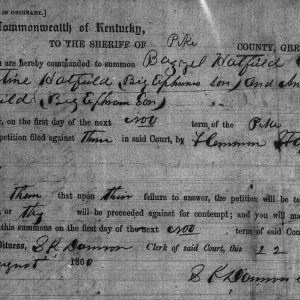On August 7, 1882, Ellison Hatfield was killed by three sons of Randolph McCoy. Both Randolph McCoy and his eldest son, Jim, testified that the troubles between them and the family of Anderson Hatfield began on that day. The same day marked the end of a much older ‘feud’ between the Hatfields and the Staffords.
From the 1850’s until 1882, every Justice of the Peace on Blackberry Creek was a Hatfield. In 1882, more than 90% of all the land on Blackberry Creek and its tributaries was owned by someone who was either named Hatfield, or who was married to a Hatfield. The Staffords, a wealthy and influential family, lived on both sides of Tug River river, above and below the mouth of Blackberry.
Probably to solidify their base on the ‘backside’ of Pike County in preparation for future county-wide elections, the Hatfields chose to support Tom Stafford for one of the two JP positions in the 1882 election. He won. Ellison lost.
Tom’s election ended a generation of bad blood between the two families. Relations between the two families had broken down in 1858, when Flem Stafford, brother of Tom’s father, Compton Stafford, was sued for slander by my 3g grandfather, George Hatfield. (Case# 1673, from 1858.)
Grandpa George was the wealthiest man on Blackberry at the time.
The charge in George’s suit was that Flem Stafford had been telling folks all over the area that Grandpa George was carrying on an illicit love affair with his MARE! Flem was said to have even told folks that George had sired several foals by his equine lover. The suit was soon followed by another suit, this time with Flem suing George and several other Hatfields. (Case# 1889, from 1860.)
From the records of the two cases, we see a semi comical farce of a ‘feud’ that occurred between 1855 and 1860.
About 1857, Flem Stafford took some timber from a tract on Blackberry Creek that was owned by George Hatfield. The plat of the 100 acre tract is in the case record. The dispute soon spawned the claim by Flem that Grandpa George was a horse lover to the max.
A witness testified that he saw the 55-year-old George and the much younger Flem meet on the road in June, 1860, at which time Flem, with a gun in his hand, cursed George as “A yellow-hided devil,” and told George that if he messed with him, he would “blow a ball through him.”
The witness swore that George turned his horse and started toward his home, with Flem armed and following him. He said that shortly after that, he saw George’s horse coming toward him, with an empty saddle. He led George’s horse toward George’s home, and found George in the road, obviously worse for wear. George told him that Flem knocked him off his horse and beat him.
In August, the Hatfields got even, giving Flem a group-thrashing he would never forget. Flem swore that he was attacked with fists, rocks, knives and guns. I am sure that the Hatfields had guns and knives, and I know that there were plenty of rocks in the road, but I doubt if Flem was subjected to more than a sound thrashing with fists. No one would survive an attack by seven Hatfields, using guns and knives.
In different parts of the record, Flem ascribes misdeeds to various combinations of the seven Hatfields named. He says that Madison and Anderson, two of George’s sons, came into his house and forced him to ride down the road with thm. Anderson is the one known as “Preacher Anse,” my 2g grandfather. Then Flem claims he was set upon by a full squad of Hatfields, including Ransom, James, Madison, Basil and Anderson, sons of George, along with two cousins who came across the river from Logan County, Virginia to assist the Blackberry Hatfields. We know who they were, because the court record lists them as Valentine (Wall) and Anderson, with the notation by each name: “Big Eph’s son.”
Flem topped it off by placing the old man, George, present as a witness to the proceedings.
This record is more proof of my long-stated contention that the moniker, “Devil Anse” originated with the New York reporter, T.C. Crawford, in 1888. The older Hatfields on Blackberry Creek during my boyhood, some of whom were well into middle age when Devil Anse died, always called him “Eph’s Anse.” If someone referred to “Anderson, or Anse Hatfield on Blackberry in 1860, folks knew they were referring to the son of George, who was later known as “Preacher Anse.” In local usage, as well as in court records, the man now known as “Devil Anse” was called “Eph’s Anse.”
Here is a summon from the case file, referring to both Valentine and Anderson as “Big Ephraim’s son.”

The case was still in court when the Civil War broke out, and its final settlement unknown, as there was no court held during the War.
My 2g Uncle, Ransom Hatfield, son of Preacher Anse told me back in the 1950’s that there was bad blood between the families until shortly before 1882, when the Hatfields decided to heal the breach by making Tom Stafford Justice of the Peace.
